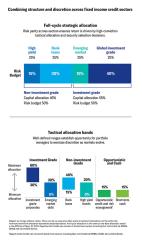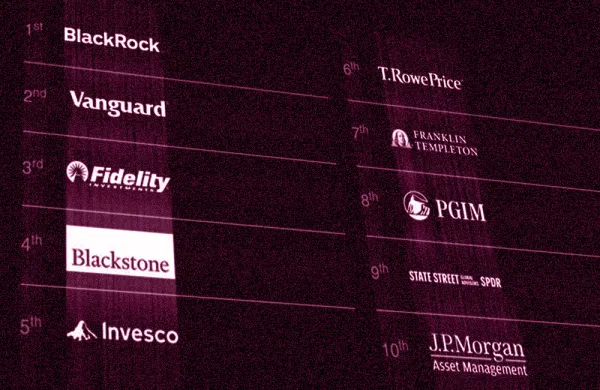You could say there are two basic approaches taken by multi-asset fixed income managers. There’s the conservative tack (think global aggregate), and in contrast, the home-run hitter who also frequently strikes out (think highly-leveraged portfolio). These two basic approaches are exposed to what the market is doing at any given moment, which can lead to up-and-down performance – a teeter-totter of returns.
But what about a multi-asset fixed income strategy built specifically to potentially deliver consistent and strong risk-adjusted returns? What would that strategy look like? Surely, it would have to be purpose-built toward that goal, as is the case with the Invesco Active Multi-Sector Credit Strategy.

“The elegance of the construction of the strategy is that anytime in the credit and rate cycle is a good time for multi-sector credit,” says Jennifer Hartviksen, Senior Portfolio Manager, Head of Global High Yield, at Invesco. “It has been designed to provide high-yield-like returns with a lower volatility profile over the full course of a cycle. So, today is a good point for it, given where we are in the investment cycle – but it’s always a good point in the cycle because of how it’s constructed.”
Flexibility a key component of elegant design
Part of the elegance in the Invesco Active Multi-Sector Credit Strategy design is its flexible nature. Within four pillar asset classes – global high yield, bank loans, emerging market debt, and global investment grade – the portfolio can be tilted at any point in the cycle to add risk or be risk averse. This full-cycle strategic aspect is accompanied by tactical allocation bands which allow portfolio managers to opportunistically position the overall strategy. There are also constraints on minimum and maximum exposure to each of the individual pillars (see below).

“One of the things that we think is unique about how the strategy is constructed is the risk-weighting of the pillar sectors,” says Ken Hill, Senior Portfolio Manager, Invesco Fixed Income Multi-Sector team. “Instead of equally weighting on market value to the sectors, we looked at past performance and spent a lot of time asking ourselves what, on a risk basis, would give each of these sectors an equal contribution.”
“The strategy is as true a credit product as you’ll find,” says Joe Portera, CIO, High Yield and Multi-Sector Credit, Invesco Fixed Income. “We don’t spend a lot of time worrying about duration, and if we do it’s mainly for capital preservation. Invesco cut its teeth on credit, and the reason we chose these four asset classes is because of the belief in our core competency in all four. Risk-adjusting the notional weights with strategic asset allocation really forces us to think in risk terms.”
Prominent role for IG
Portera and his team don’t worry too much about duration because of the significant part investment grade (IG) credit plays in the strategy. “The proof is in the pudding. IG has probably been the top performer of the four pillars. And the duration exposure from IG provides a natural hedge to the leveraged credit exposure in this strategy, and we can certainly add to that should we choose,” he says.
IG corporates and emerging market (EM) debt account for the investment grade half of the risk budget in the strategy, with IG corporate at anywhere from 30% to 60% of the IG tactical allocation band (with EM debt ranging from 0% to 30%). Those current ranges demonstrate the flexibility in the strategy.
“When we originally launched the strategy six years ago, we set a range of 40% to 70% for the investment grade component of the strategy, which gives us the flexibility to adjust the portfolio’s risk as market conditions evolve. This tactical band includes investment grade rated EM debt.” says Hartviksen. “The EM marketplace’s credit profile has weakened since the inception of the strategy, so we reduced the allocation to that sleeve about three years ago. However, at a minimum, 60% of what is in the EM bucket still has to be rated investment grade. We are very conscious of the fact that we don't want this to be a leveraged credit portfolio on an ego trip. We want to balance the potentially very good returns you can get from high yield, whether it’s bank loans or fixed rate securities, with the notion that the inherent risk needs to be controlled.”
According to Portera, he goes to great lengths to emphasize to the credit pillar managers that “this is not your plain vanilla, benchmark-focused IG portfolio. In fact, no part of this strategy is plain vanilla. Our credit pillar managers know not to tell me they have invested in a name solely because it’s a big part of the benchmark. That’s not our goal. Our goal is to deliver the best income and capital appreciation opportunities within each asset class.”
Performance tied to global teamwork
Since the strategy’s inception in 2013, it has delivered similar returns compared to global high yield markets, with less volatility, stronger risk adjusted metrics, and noticeably lower maximum drawdown (see below). This is due in large part to the teamwork at Invesco. Under the umbrella of the Active Multi-Sector Credit Strategy, specialist portfolio managers in each credit asset class are responsible for those individual sector portfolios, and collaborate with Portera, Hartviksen, and Hill, who are responsible for the overall risk management of the strategy and the opportunistic bucket.
“To manage a strategy like this, you need an interconnected team on a global platform with depth and breadth across geographies and various fixed income segments like high yield, investment grade, and bank loans,” says Hartviksen. “Everyone comes together to have regular conversations and share ideas. At Invesco, these teams come together on a daily, weekly, quarterly, and semi-annual cadence. We [Portera, Hartviksen, and Hill] participate in various sector calls, so we identify opportunities outside of the four key pillars. So, if municipal credits are attractive, we can put that in the strategy We also hear about different themes on these calls, such as those around oil or natural resources, for example, and when appropriate, we make sure they are represented in the portfolio. Our integrated teams each have their own areas of individual responsibility, which, combined with our integrated asset allocation and risk management, is what makes the strategy come to life.”
Start a conversation about your fixed income portfolio. Learn more.
NA 8609






